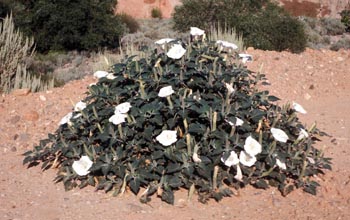Jimsonweed

Common Name(s):
Jimsonweed
Sacred Datura
Devil’s Trumpet
Jimpson Weed
Jamestown Weed
Moonflower
Scientific Name:
Datura stramonium L.
Scientific Name Synonyms:
Datura tatula L.
Symbol:
DAST
Description:
Life Span: Annual
Origin: Introduced
Growth Characteristics: When mature, Jimsonweed plants are erect, 1.75 to 4 feet tall, often with a similar spread. It often falls over from its own weight. Jimsonweed germinates readily and self sows under most conditions.
Flowers: Showy white to purple trumpet flowers are 2 to 4 inches long. Individual flowers occur on short stalks that arise from leaf or branch axils. The sepals enclose the lower part of the flower. Flowers open for only one evening, but new ones continue to open throughout the summer and autumn.
Fruits/Seeds: Fruit is a four-segmented egg-shaped capsule, 1-2 inches long, covered with stiff prickles. The capsule opens from the tip when ripe, exposing many dark, pitted seeds with tiny wrinkles.
Leaves: Jimsonweed leaves have an unpleasant odor when slightly bruised. The first true leaves are spade-shaped and have many veins and appear somewhat puckered. Mature leaves are elliptical to egg-shaped, uneven at the margins, and show puckering between the veins. They are 3-8 inches long, 6 inches wide, on long, stout petioles. Margins of leaves have a few large triangular teeth.
Stems: Very stout, hollow, smooth, branching, green or more often purple, with inconspicuous hairs.
Roots: A thick and extensively branched taproot system.
Ecological Adaptions:
Jimsonweed prefers warm growing areas. It competes aggressively for water and grows rapidly. It is a common weed in pastures, barnyards, roadsides, and waste places.
Soils: Occurs on a wide variety of soil types.
Associated Species: Big sagebrush, Utah juniper.
Uses and Management:
Most parts of the plant contain atropine, scopolamine, and hyoscyamine. Jimsonweed and its derivatives have several medicinal uses. At low doses, it is used to treat asthma, muscle spasms, and symptoms of Parkinson’s disease. At higher doses it causes hallucinations.
It is occasionally grown as an ornamental, and attracts bees, butterflies, and moths.
All parts of jimsonweed are very poisonous. Cattle and sheep have died from eating it. Symptoms include dilated pupils, thirst, fever, loss of coordination, confusion, rapid pulse, labored respiration, hallucinations, convulsions, and eventual coma. Even inhaling the sweet fragrance of the flowers can cause headaches and dizziness. The sap can cause a skin rash.

